In the exciting world of technology, new terms appear every day, mysteriously twinkling like stars in the endless cosmos of the information space. Among them is the word “potal.”
What is gold leaf? Some call it “fake gold”, others call it “poor man’s gold”, but in fact it is a modern alternative to gold leaf – more affordable and less demanding to process. It is used for gilding a variety of materials and surfaces.
Areas of application for gold leaf
Gold leaf consists of the thinnest metal sheets used for covering items. It can be used in loose form, as flakes, decals, or in transfer techniques.
The choice of gold leaf type depends on your needs and individual preferences. However, it’s difficult to say which gold leaf is the best, as the decision depends solely on your comfort and convenience.
With gold leaf, you can achieve a gilding effect.
And gilding is widely used for decorating jewelry, furniture, moldings, and ceramics.
Despite its attractive and luxurious golden hue, gold leaf does not contain precious metals. This is why the gilding process remains a budget-friendly option, allowing you to add the natural shine of noble metal to your artwork.
But gold leaf does not only imitate gold. With this material, you can achieve a shine resembling silver or copper.
Depending on the components, the substance is formed with a golden, silvery, or coppery tint. Distinguishing high-quality gold leaf from real gold with the naked eye is extremely difficult, which sometimes leads to confusion, and many mistakenly believe that gilding involves using precious metals to decorate items or paintings.
Gold leaf can be used to decorate:
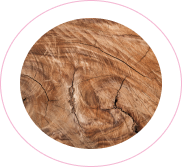
wood;
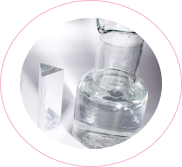
glass;
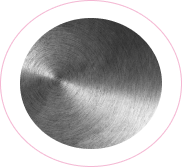
metal;

mirrors;
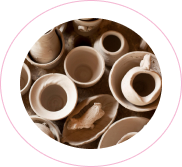
ceramics;

gypsum moldings;
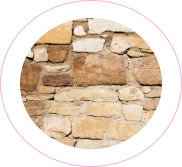
decorative stone;

textiles;

and also add colorful elements to artworks.
Potal in painting
In painting, gold leaf plays a significant role. How do artists use this material? Now it is clear — gold leaf provides a gilding effect.
To apply gold leaf to an artwork, a special water-based glue and a synthetic brush are used. The glue is applied to the areas intended to be covered in gold, after which a sheet of gold leaf is applied to the sticky glue, and the canvas is left to dry for a while.
After the glue under the gold leaf has fully dried, excess material is removed with a bristle brush, leaving only the areas that were meant to be highlighted in gold.
It creates the impression that your painting is made entirely or partially of gold.
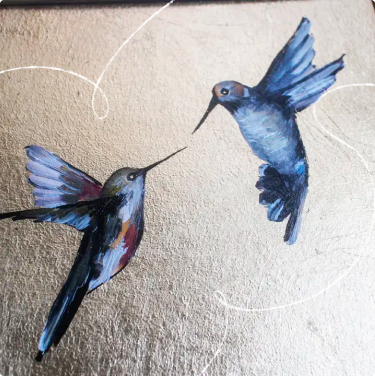
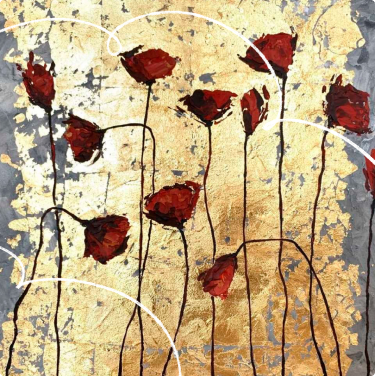
Types of gold leaf
Gold leaf products come in various options, allowing you to explore your creative potential in different techniques and when working with various surfaces.
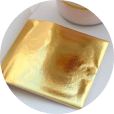 Sheet Gold Leaf (Classic) is available in various formats and is sold in small books. This type of gold leaf is convenient for decorating large areas of surface.
Sheet Gold Leaf (Classic) is available in various formats and is sold in small books. This type of gold leaf is convenient for decorating large areas of surface.
Sheet gold leaf is suitable for working with various materials: wood, glass, ceramics, metal, or canvas.
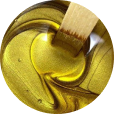
Liquid Gold Leaf. Working with this material is very simple, making it an excellent choice for beginners in art. The application process is similar to working with regular paint using a synthetic brush. Liquid gold leaf easily mimics metallic shine and adheres well to any surface.
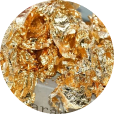
Gold Leaf Flakes are an essential material for creating crackle effects, providing unique visual color transitions.
This material is also known as “gold leaf flakes,” visually resembling small crumpled bits of aluminum foil.
Like sheet gold leaf, these flakes are available in three main colors: bronze, silver, and gold. They are widely used in jewelry making because the facets of the flakes create many delicate reflections and shimmer.

Paste Gold Leaf is a convenient material because once it dries, the surface can be easily polished to give it a pronounced shine.
This type of gold leaf is ideal for gilding metal, leather, or wood. The paste is applied with a brush, although layers can also be formed by hand. It is sold in glass jars and does not require dilution as the material is ready for use right after opening.
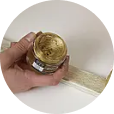
Wax Gold Leaf is needed for gilding items that will not be subjected to friction or mechanical stress. This material is primarily your practical choice.
It can act not only as a coating but also as a primer, filling small cracks in the surface. Wax gold leaf can also create textured surfaces. The application technique of this material is almost identical to that used with paste.

Mirror Gold Leaf, also known as synthetic or super gold leaf, is a material that does not contain metals in its composition.
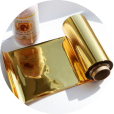
Transfer Gold Leaf — decorative foil with shine, capable of mimicking noble metals depending on its color. It can also create a holographic effect.
Pros and cons of classic gold leaf
Advantages:
- Qualitatively mimics gold leaf. It has a noble shine that closely resembles precious metals.
- Low cost.
- Due to its wide availability, gold leaf is easily purchased both in retail art supply stores and on marketplaces.
- Working with gold leaf is much simpler than with real gold leaf, and mistakes during material processing are more economical.
- The material is also easy to clean, does not tend to crumble significantly, which prevents it from sticking to the surface without a special varnish.
- It is important to note that this material is not flammable.
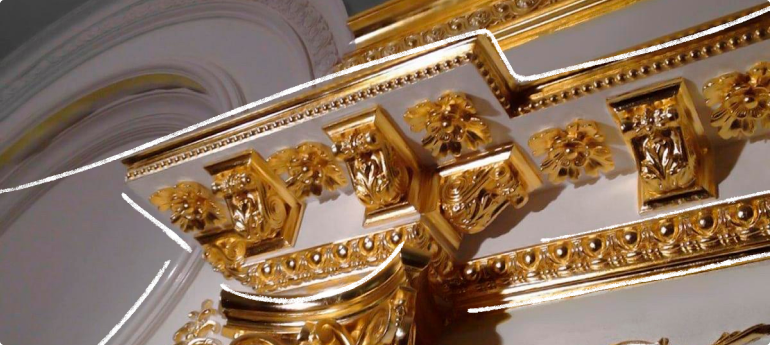
Disadvantages:
- Susceptible to oxidation. Due to the metals in its composition, it often undergoes oxidation and is not resistant to water exposure. Even with the use of special varnish, oxidation traces may appear over time, and unfortunately, restoring the condition is impossible.
- It is impossible to achieve a completely seamless coverage. When creating a uniform gold background, seams between sheets will be visible to the naked eye.
- Special glue is required for applying this gold leaf to a surface.
Pros and cons of mirror gold
Advantages:
- The brightness of this product is fully revealed under sunlight, attracting attention with its shimmering brilliance.
- A glossy effect is always guaranteed, regardless of the smoothness of the base surface.
- The cost of this leaf is the same as that of classic gold leaf.
- Available for purchase and easy to find.
- Not prone to oxidation and water-resistant. No additional protective varnish is required. For paintings using this leaf, it is sufficient to cover it with acrylic varnish, just like the rest of the painting.
- Allows for soft transitions due to its thinness and fragility, without turning into dust.
- Has a reflective surface, distinguishing it from other types of leaf.
- Extensive color palette includes various shades of gold, silver, and bronze, as well as colored leaf options, expanding the choice possibilities.
- Wide range of applications: from using entire sheets for decorating finished products to adding flakes into epoxy resin or plaster when creating various items.
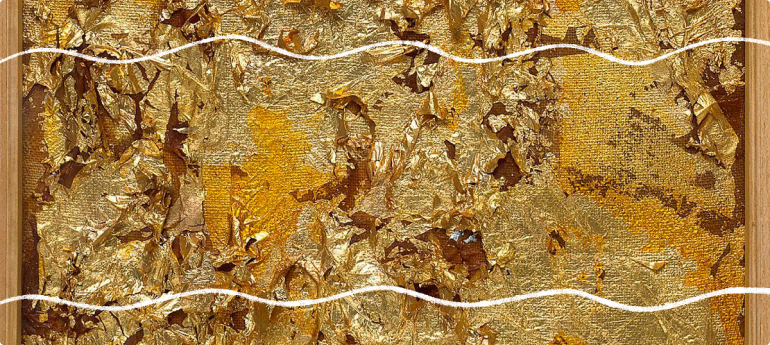
Disadvantages:
- Difficult to clean. The material easily breaks into small pieces and may stick to areas of the item not covered with glue.
- Flammability. Prone to easy ignition.
- Requires special glue for application to the surface.
- Need for using a respirator during work.
Pros and cons of transfer gold
Advantages:
- Suitable for decorating various durable surfaces, such as glass, metal, ceramics, wood, paintings, figurines, as well as for decoupage and other creative projects.
- Unlike regular leaf foil, this gold leaf does not tear or scatter, providing ease of use and eliminating the need to collect small pieces that may disperse.
- Allows for creating images with clear contours, making the creative process simpler compared to using regular leaf foil.
- Due to the lack of oxidation, it does not require additional coating with special lacquer; regular acrylic is sufficient and it is not susceptible to moisture.
- Easier to work with compared to using leaf foil.
- Offers a diverse palette, including options with a holographic effect.
- Difficult to find in retail stores but widely available on marketplaces.
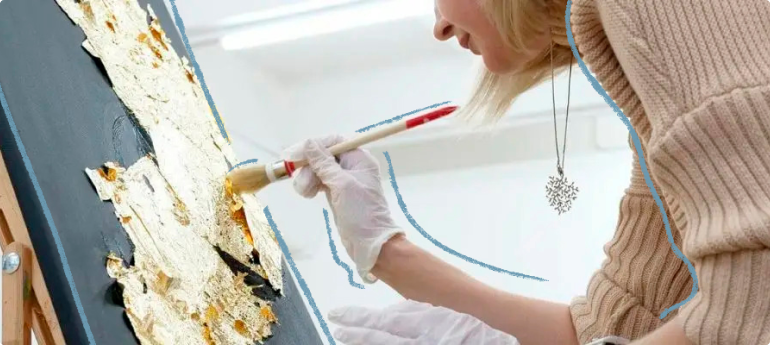
Disadvantages:
- Shines only from certain angles.
- Has limited application and is not suitable for creating a golden background.
- Best used for gilding finished items; inconvenient for working with convex shapes, depressions, and textured surfaces.
- Considered a material for beginners and hobbyists among artists.
- Requires the use of special glue for application on surfaces.
Pros and cons of liquid gold
Advantages:
- Dries quickly and is suitable for a variety of surfaces.
- Known for its ease of use—applies easily with a brush, does not require additional materials such as special glue or finishing varnish.
- Has insufficient density as it is water-based.
- Excellent for covering various surfaces, including textured ones, whether they are leather, metal, wood, or glass.
- Great for finishing the edges of items, such as plaster trays, and for creating golden splashes or paintings in fluid art techniques.
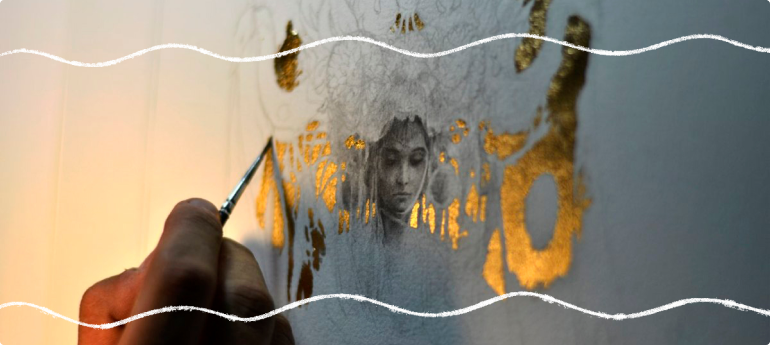
Disadvantages:
- Has a strong odor, so it is recommended to use a respirator and work in a well-ventilated area. Moreover, this smell may persist for a long time, even if the room is well-ventilated.
- Lacks shine, more closely resembling matte gold.
- Availability of this product may be limited and not always found in retail stores, but it can be found on various marketplaces.
- There is a risk of purchasing counterfeits, as sellers often offer regular metallic paint as liquid gold leaf.
Pros and cons of wax for gilding
Advantages:
- Convenience in application. Can be applied using various tools, from fingers to brushes or cloths. After drying, simply wipe with a dry cloth to add shine.
- Economical use.
- Safe composition, free from toxic components and unpleasant odors.
- Evenly distributes over the surface without accumulating in recesses, making it ideal for highlighting textures.
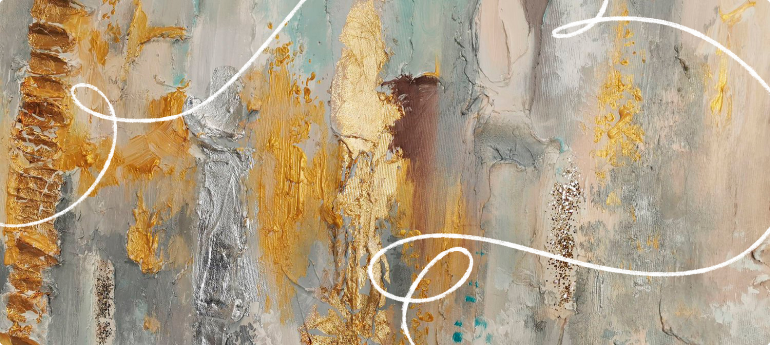
Cons:
- Not suitable for use on flat surfaces. Creating a perfectly smooth gold surface is impossible.
Materials and tools for working with gold leaf
The gilding process is more complex than it might seem at first glance, and the gilding leaf itself is one of those decorative elements that can be demanding.
You should only start working if you have all the necessary tools and additional materials at hand. What will you need?
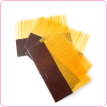
Lampenbrush — this is not an ordinary tool for the layperson. In fact, it is a wide flat brush with squirrel hair used for applying gilding to the item. This tool is suitable for working with sheets. Externally, the lampenbrush differs from a traditional brush because it does not have a regular handle. Its shape resembles a spatula with a fan-shaped or rectangular bristle.

Column Brush, also known as a column brush, is another unusual tool that differs from a regular painting brush. Unlike a fine bunch of bristles, the column brush has bristles arranged in a fan shape. Using a column brush, you can smooth out the gilding applied to the surface, preventing damage to the material layer.
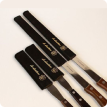 Gilder’s Knife is designed for precise trimming of gilding sheets. The blade of this knife can be very sharp, but its main working surface is a rounded edge. When using this knife, the gilding sheets are not cut but rather pierced or pressed.
Gilder’s Knife is designed for precise trimming of gilding sheets. The blade of this knife can be very sharp, but its main working surface is a rounded edge. When using this knife, the gilding sheets are not cut but rather pierced or pressed.
 Gilding Cushion for handling gilding sheets. Made from fine suede, it is equipped with a special screen around the perimeter to prevent even the smallest air movements and protect the delicate elements of the gilding material. It is important that the gilding sheet fits entirely on this cushion.
Gilding Cushion for handling gilding sheets. Made from fine suede, it is equipped with a special screen around the perimeter to prevent even the smallest air movements and protect the delicate elements of the gilding material. It is important that the gilding sheet fits entirely on this cushion.
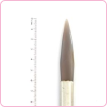 Agate Points — often used tools in the final stage of the gilding process. The various shapes of these points allow for polishing surfaces with complex reliefs, including areas with the finest indentations and irregularities.
Agate Points — often used tools in the final stage of the gilding process. The various shapes of these points allow for polishing surfaces with complex reliefs, including areas with the finest indentations and irregularities.
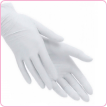 Gloves — an essential attribute when working with thin metal sheets, requiring the artist’s experience and precision. To prevent fingerprints from appearing on the surface, special lightweight gloves are used. Interacting with gold, in any form, is not recommended without protection. Using cotton gloves provides the artist with greater freedom of movement.
Gloves — an essential attribute when working with thin metal sheets, requiring the artist’s experience and precision. To prevent fingerprints from appearing on the surface, special lightweight gloves are used. Interacting with gold, in any form, is not recommended without protection. Using cotton gloves provides the artist with greater freedom of movement.
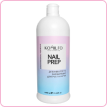 Degreaser. Thorough surface preparation is essential before starting any work. An effective tool in this process is a degreaser, which effectively removes grease and fine dust particles. This step is particularly important as it ensures excellent adhesion of the gilding to the treated surface. It is recommended to degrease even if gilding is applied over a primer.
Degreaser. Thorough surface preparation is essential before starting any work. An effective tool in this process is a degreaser, which effectively removes grease and fine dust particles. This step is particularly important as it ensures excellent adhesion of the gilding to the treated surface. It is recommended to degrease even if gilding is applied over a primer.
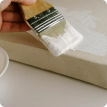 Gilding Primer performs its primary function, playing an important role in decorative work. Its use is not limited to just smoothing surfaces; it also serves as a base for varnishes, paints, and other finishing materials.
Gilding Primer performs its primary function, playing an important role in decorative work. Its use is not limited to just smoothing surfaces; it also serves as a base for varnishes, paints, and other finishing materials.
Features of working with gold leaf: an example of gilding
- The processing of the item begins with sanding the surface, degreasing it, and applying a primer, after which it should be allowed to dry. Excess marks should be removed immediately with a cloth, without waiting for the primer to fully dry.
- The next stage is applying glue. After the primer layer has completely dried, the surface is covered with glue. Due to varying drying times for different types of glue, it is recommended to carefully review the manufacturer’s instructions.
- The process of applying gilding begins with careful preparation and transferring it to the surface with a lampenbrush so that the sheets overlap, without gaps. After that, the material should be smoothed with a column brush or a soft cloth, pressing down on the surface. When working with gilding flakes, it is important to distribute them in an even layer, then press them with a cotton pad. Excess elements should be removed with a brush, and gaps in the coverage should be filled with pieces of material.
- The final stage is polishing. If gesso was used as a base, the item can be polished with a soft cloth, moving from the corner. This will help to eliminate any irregularities and seams. To protect the item from dust and wear, a clear varnish is used, which is applied with a wide brush. First in one direction, then in another, ensuring complete surface coverage and avoiding missed spots.

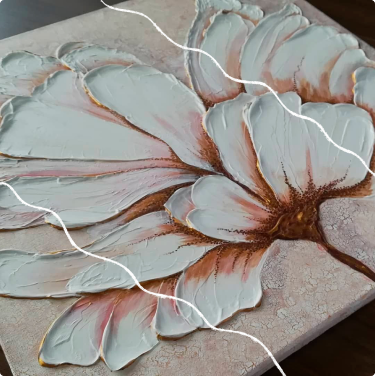
Popular techniques and methods of working with gold leaf
In our time, even those just starting their journey in art do not face a lack of information, thanks to the availability of tutorial videos on various techniques on the Internet.
And if you don’t want to watch detailed videos, read about some of the most popular techniques where various types of gilding are widely used.
- The use of the stretching method in visual arts provides a unique opportunity to work with surface texture, especially effective when working with flakes. The artist can form or adjust the gilded layer directly on the surface, making this method particularly suitable for creating crackle effects, widely known in the art world.
- The technique of applying sheets — is a relatively simple gilding method used for decorating large surfaces. Gold sheets are adhered to the prepared surface using various methods.
- Texture formation is achieved by applying gilding to the surface and then placing a stamp on top. Excess material is then removed, leaving the gilded coverage only in the depressions created by the stamp.
- Using epoxy resin to create three-dimensional decorative elements. Epoxy resin has many positive properties, making it an ideal material for various decorating techniques. By pouring flakes with a layer of resin or using a step-by-step pouring method, you can achieve a beautiful three-dimensional effect.
- The technique of mixing materials. In this method, powder or flakes are combined with paint, and the mixture is then applied to the item.
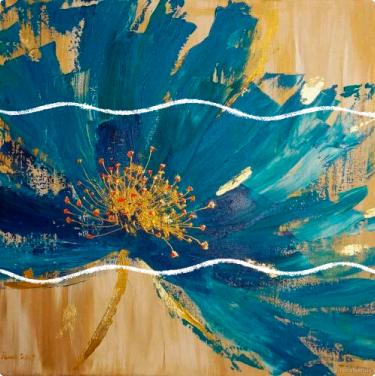
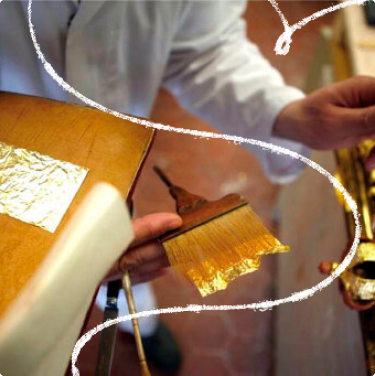
And finally...
When working with gold leaf, it is important to consider several aspects: it is recommended to be in a draft-free room, since gold leaf is a lightweight material and can easily fly away in a draft. It is also necessary that there is enough light in the room, you must clearly observe your work process.




